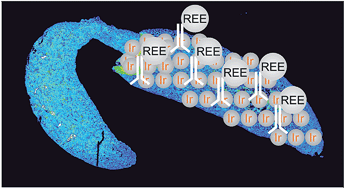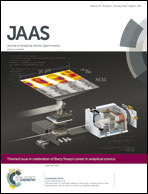An internal standardisation strategy for quantitative immunoassay tissue imaging using laser ablation inductively coupled plasma mass spectrometry†
Abstract
Laser ablation inductively coupled plasma mass spectrometry (LA-ICP-MS) for imaging of biological materials, such as tissue sections, has gained growing attention in the last few years, and even more since the coupling with isotopically enriched and labelled antibodies for quantitative immunoassays became available. In this work, an internal standardisation strategy for the quantitative imaging analysis of biological samples by LA-ICP-MS using labelling with an iridium compound is proposed. The utilisation of an iridium intercalator offers the advantage that the internal standard does not only correct for drift and matrix effects but also correct for differences in the ablated mass at the same time. For this, the applicability of the internal standard was investigated for formalin fixed paraffin embedded tissues (FFPEs) and for cryosections. Background contamination and thickness correlation were studied. As a proof of concept, the quantification of an isotope labelled mouse anti-E-Cadherin antibody was performed on a FFPE kidney section of a mouse at different spatial resolutions.

- This article is part of the themed collection: Themed issue dedicated to Barry Sharp

 Please wait while we load your content...
Please wait while we load your content...